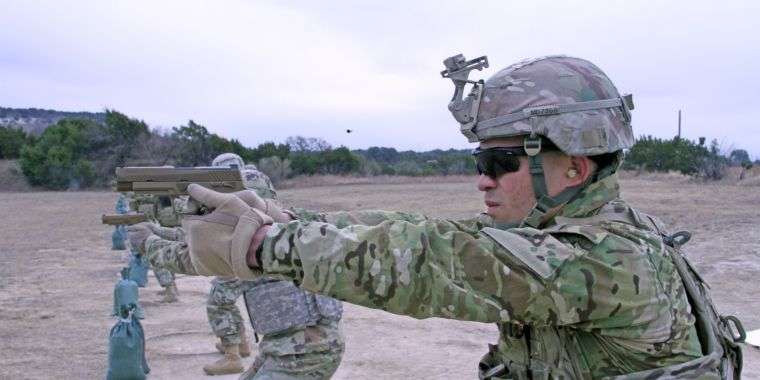
After a few misfires, Army’s newest pistol program is slow on the draw

After a nearly decade-long effort to pick a new pistol for the US military, the Army’s Program Executive Office‑Soldier awarded its Modular Handgun System (MHS) contract to SIG Sauer on January 19, 2017. More than two years later, the Army says that the program is still on track for planned purchases—but the Army’s budget requests for 2020 indicate that the service is slowing its draw for at least the next year.
The MHS program is the Army’s effort to replace the pistol that has been the standard military sidearm since 1986—the Beretta M9, which had been the Army’s first service-wide pistol since the venerable Colt M1911 .45 caliber pistol. SIG Sauer’s pistols for the MHS program are based on SIG Sauer’s P320 pistol—a favorite of law enforcement. Like the Beretta M9, both the full-size XM-17 and compact XM-18 are chambered for 9-millimeter bullets. But the MHS pistols are primarily designed to fire a “special purpose” bullet—a jacketed hollow point round intended, as the Army’s requirements documents stated, to “create a larger wound channel.”
It took more than a decade for the MHS program’s managers to pick a winner. In October of 2015, Senator John McCain—then chair of the Senate Armed Services Committee, called the MHS program a “costly misfire in which it has taken 10 years and wasted potentially tens of millions of dollars in order to purchase simple handguns.” And even after the Army finally selected SIG Sauer’s design, the problems continued—starting with a lawsuit for patent infringement in the design of the pistol.
The problems continued in testing. In its annual report for fiscal year 2017, the Department of Defense’s Office of the Director of Operational Test and Evaluation (DOTE) cited several serious issues. First there was the pistol’s problem with accidental discharge: “during drop testing in which an empty primed cartridge was inserted, the striker struck the primer causing a discharge.” This problem was also discovered by outside testers, who showed that the weapon would go off if it landed at an angle not usually covered by drop tests. SIG Sauer implemented a fix in the trigger mechanism of the pistols, but DOTE noted that “this fix may have contributed to the splintering of two triggers during the IOT&E [initial operational testing and evaluation].” The “splintering” didn’t prevent the pistols from firing, but it affected the smoothness of the trigger pull.
Both pistols had another problem—”double-ejections,” where unspent ammunition was spit out along with the cartridge of a fired round. This happened with increasing frequency during the Army’s Product Verification Test (PVT), leading to an ongoing Army effort to find the root cause. There hasn’t been a statement on the findings of that investigation. And the smaller XM18 suffered an unacceptable number of jams and stoppages during firing with standard ball ammunition, though it was deemed reliable enough for combat using the hollow-point rounds designed for MHS.
The Army plans to purchase 233,429 pistols over the life of the MHS program—mostly the full-size XM17—while the other services will purchase the more compact XM18 off the Army’s contract, but it’s only projecting delivery of about 19,000 of them in 2019. And while the Army says it’s on target for planned purchases in 2020, the service is asking for only $6 million for MHS purchases in fiscal 2020, down from $48 million in 2019. That’s a drop in the Army’s overall procurement bucket, but the service is shuffling around a lot of its budget to fuel new modernization goals.
Listing image by Staff Sgt. Taresha Hill 3d Cavalry Regiment Public Affairs Office




